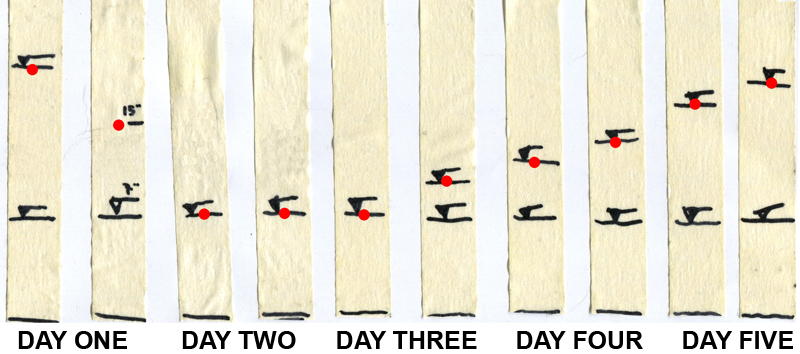I made a new starter few days ago, just to taake photos of the process.
I started with 100g (tap) water, 50g AP flour and 50g rye flour, let it sit 24 hours at room temperature. It almost tripled it's volume.
The next day I switched to a 12 hours feedeing schedule, keeping 75g culture, adding 75g water, 50g AP flour and 25g rye flour. Here are some pictures taken in day 2, 3, 4
after day 4, I feed it only with APflour and water, and in day 5 it looked like that:
The smell changed during these days, from sour, sprouted grains, yogurt, sweet and sour, yeast.
This is how it developed in 5 days:

I'm happy with the result, but I don’t know what to do with it now, cause I don’t want to keep two starters, I want to give it away, but I’m from Romania and I don’t know if there is a safe way to “mail” it. It's a shame to throw it away in the garbage...
I'll bake a bread with it to see if it has a different taste than my old starter, I'm very curious.
For a complete post and pictures, you ca visit my romanian blog Apa.Faina.Sare. (whitch means Water. Flour.Salt.)
And if any of you have any idea what to do with it... I'm all ears.
codruta
- codruta's Blog
- Log in or register to post comments
no need to waste old starter, just incorporate as much of it as you want as "old dough" into your next bread recipe. Of course, you'll need to adjust the flour and hydration a bit because you're adding more 100% hydration starter, as well as your fermentation times....
OR you can use Flo's 1-2-3 style sourdough recipe (search the forums), so you can build your dough based only on the quantity of sourdough you have...
OR you can also freeze some old starter to keep in case your current starter dies...
OR make some sourdough pancakes or waffles! :)
thanks for the suggestion, just one observation: I don't intend to waste my old good starter, that one is a keeper.
I don't know what to do with that new good looking one, but flo's recipe sounds like a good idea.
I'm not sure at day 5 you actually have a 'sound' starter. It might raise bread, it might not depending on dough hydration. If it did, I would highly doubt it would taste very good from such an immature and unstable culture. The pics you have provided show thousands of very tiny bubbles, whereas a good healthy starter should have a variety of sizes of bubbles. It appears that if you used tap water and nothing else (pineapple juice, for example), then what you have right now is a lot of Leuconostoc and other preliminary organisms that all produce a ton of gas.
For comparison, here is a vigorous and healthy starter that just peaked and has crashed a little bit (I was just about to feed it). Notice the difference in co2 pockets it creates. Back when my starter looked like yours (all those zillions of uniform and very small bubbles), it was not able to be baked with. Pictures are only part of the story, your starter may be as healthy as any, just providing contrast here.
- Keith
Keith, I don't intend to bake bread in day 5 or 6, I'll wait few more days, most likely another 7 days. The last picture I provided was from day 5, before the feeding. I'm at day 8 now, and it looks very vigurous when fed, more like a sponge rather than foam. It floats when put in a bowl of water and smells very pleasant. I can't give a final verdict till I'll bake a bread, but I'll share with you my conclusions then.
Ok, thanks for the clarification. You said you intended to bake with it, but didn't say when. Good luck with the newborn! ; )
- Keith
hello again. Can you please tell me what hydration is your starter? the one in the picture?
Cool how it makes a graph laid out like you did. Clear to see the steady growth after day three. Neat idea in presenting the results!
mini, I thought it would make a nice picture, and it summarize the whole process. :)